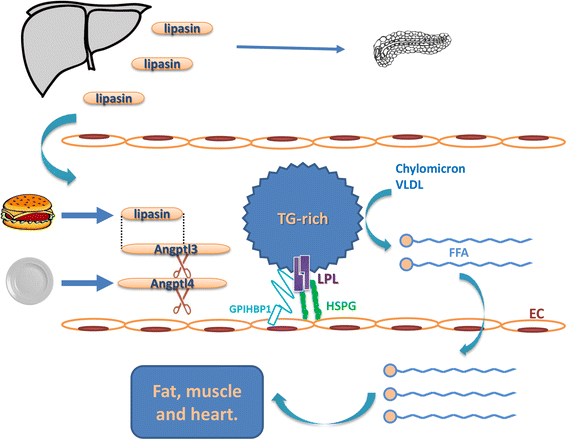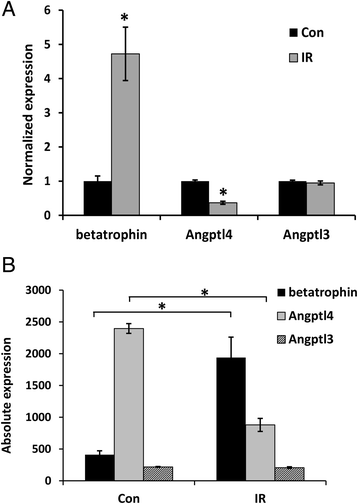A dual role of lipasin (betatrophin) in lipid metabolism and glucose homeostasis: consensus and controversy
- PMID: 25212743
- PMCID: PMC4172915
- DOI: 10.1186/s12933-014-0133-8
A dual role of lipasin (betatrophin) in lipid metabolism and glucose homeostasis: consensus and controversy
Abstract
Metabolic syndrome includes glucose intolerance and dyslipidemia, both of which are strong risk factors for developing diabetes and atherosclerotic cardiovascular diseases. Recently, multiple groups independently studied a previously uncharacterized gene, officially named C19orf80 (human) and Gm6484 (mouse), but more commonly known as RIFL, Angptl8, betatrophin and lipasin. Both exciting and conflicting results have been obtained, and significant controversy is ongoing. Accumulating evidence from genome wide association studies and mouse genetic studies convincingly shows that lipasin is involved in lipid regulation. However, the mechanism of action, the identity of transcription factors mediating its nutritional regulation, circulating levels, and relationship among lipasin, Angptl3 and Angptl4, remain elusive. Betatrophin represents a promising drug target for replenishing β-cell mass, but current results have not been conclusive regarding its potency and specificity. Here, we summarize the consensus and controversy regarding functions of lipasin/betatrophin based on currently available evidence.
Figures


Similar articles
-
Betatrophin.Islets. 2014;6(2):e28686. doi: 10.4161/isl.28686. Islets. 2014. PMID: 25483956 Free PMC article.
-
Elevated circulating lipasin/betatrophin in human type 2 diabetes and obesity.Sci Rep. 2014 May 23;4:5013. doi: 10.1038/srep05013. Sci Rep. 2014. PMID: 24852694 Free PMC article.
-
Emerging regulation and function of betatrophin.Int J Mol Sci. 2014 Dec 18;15(12):23640-57. doi: 10.3390/ijms151223640. Int J Mol Sci. 2014. PMID: 25530616 Free PMC article. Review.
-
Emerging roles of Lipasin as a critical lipid regulator.Biochem Biophys Res Commun. 2013 Mar 15;432(3):401-5. doi: 10.1016/j.bbrc.2013.01.129. Epub 2013 Feb 13. Biochem Biophys Res Commun. 2013. PMID: 23415864 Review.
-
The Arg59Trp variant in ANGPTL8 (betatrophin) is associated with total and HDL-cholesterol in American Indians and Mexican Americans and differentially affects cleavage of ANGPTL3.Mol Genet Metab. 2016 Jun;118(2):128-37. doi: 10.1016/j.ymgme.2016.04.007. Epub 2016 Apr 19. Mol Genet Metab. 2016. PMID: 27117576 Free PMC article.
Cited by
-
A lipasin/Angptl8 monoclonal antibody lowers mouse serum triglycerides involving increased postprandial activity of the cardiac lipoprotein lipase.Sci Rep. 2015 Dec 21;5:18502. doi: 10.1038/srep18502. Sci Rep. 2015. PMID: 26687026 Free PMC article.
-
Different relationship between ANGPTL3 and HDL components in female non-diabetic subjects and type-2 diabetic patients.Cardiovasc Diabetol. 2016 Sep 13;15(1):132. doi: 10.1186/s12933-016-0450-1. Cardiovasc Diabetol. 2016. PMID: 27620179 Free PMC article.
-
Analysis of the Expression and Prognostic Potential of a Novel Metabolic Regulator ANGPTL8/Betatrophin in Human Cancers.Pathol Oncol Res. 2021 Sep 27;27:1609914. doi: 10.3389/pore.2021.1609914. eCollection 2021. Pathol Oncol Res. 2021. PMID: 34646087 Free PMC article.
-
The role of ANGPTL3 in controlling lipoprotein metabolism.Endocrine. 2016 May;52(2):187-93. doi: 10.1007/s12020-015-0838-9. Epub 2016 Jan 11. Endocrine. 2016. PMID: 26754661 Free PMC article. Review.
-
ANGPTL8: An Important Regulator in Metabolic Disorders.Front Endocrinol (Lausanne). 2018 Apr 17;9:169. doi: 10.3389/fendo.2018.00169. eCollection 2018. Front Endocrinol (Lausanne). 2018. PMID: 29719529 Free PMC article. Review.
References
-
- Klein S, Burke LE, Bray GA, Blair S, Allison DB, Pi-Sunyer X, Hong Y, Eckel RH. Clinical implications of obesity with specific focus on cardiovascular disease: a statement for professionals from the American Heart Association Council on Nutrition, Physical Activity, and Metabolism: endorsed by the American College of Cardiology Foundation. Circulation. 2004;110:2952–2967. doi: 10.1161/01.CIR.0000145546.97738.1E. - DOI - PubMed
-
- Miller M, Stone NJ, Ballantyne C, Bittner V, Criqui MH, Ginsberg HN, Goldberg AC, Howard WJ, Jacobson MS, Kris-Etherton PM, Lennie TA, Levi M, Mazzone T, Pennathur S. Triglycerides and cardiovascular disease: a scientific statement from the American Heart Association. Circulation. 2011;123:2292–2333. doi: 10.1161/CIR.0b013e3182160726. - DOI - PubMed
-
- Haffner SM. Management of dyslipidemia in adults with diabetes. Diabetes Care. 2003;26(Suppl 1):S83–S86. - PubMed
Publication types
MeSH terms
Substances
LinkOut - more resources
Full Text Sources
Other Literature Sources
Miscellaneous

